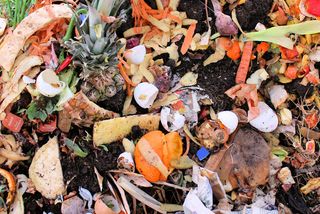Live News Feed for My Area
6 Ways to Feed 11 Billion People

Feeding the world's growing population will not be an easy task. By 2100, it's estimated that there will be 11 billion people on the planet, 3 billion more than there are today. And 870 million people worldwide are already chronically hungry.
The planet can definitely produce enough food for 11 billion people, experts say, but whether humans can do it sustainably, and whether consumers will ultimately be able to afford that food, are separate matters. Humans can't rely on a single solution to feed a population of this size, experts say. A number of different strategies will be required, each of which will move humans a little bit closer toward closing the gap between the amount of food they have, and the amount of food they need.
Here are six possible strategies to help feed 11 billion people:
Eat less meat
As society tries to feed the growing population, it will have to pay close attention to the use of the Earth's resources, or risk making the situation worse.
Beef in particular is not a very sustainable food to eat, said Jamais Cascio, a distinguished fellow at the Institute for the Future, a think tank in Palo Alto, Calif. According to Cascio's calculation, the greenhouse gas emissions generated by the production of cheeseburgers in the United States each year is about equal to the greenhouse gas emissions from 6.5 million to 19.6 million SUVs over a year.
To feed 11 billion people, Americans will need to eat differently than they do today, which may involve eating more vegetables, which take much less energy to produce, and less meat, Cascio said. [What 11 Billion People Mean for Food Security]
Eat fake meat?
Another, perhaps more outlandish, solution may be to eat meat that isn't from an animal at all. Scientists have been working to develop cultured meat, or synthetic meat grown in a lab. Earlier this year, researchers in the Netherlands showcased their lab-grown burger, and allowed a taste test. However, right now, the cost is exorbitant (a single burger costs $325,000), and it does not taste exactly like meat (taste-testers said the burger was dry). But with future research, the price is likely to come down, and the product's taste could improve, Cascio said.
However, some have been skeptical that lab-grown meat would be truly more sustainable than meat from cows. Cultured meat still requires nutrients, and currently, researchers "feed" lab meat, in part, with blood from cow fetuses, according to a 2012 Discover Magazine post by Christina Agapakis, a synthetic biologist at UCLA. Researchers have proposed that they could one day use algae to feed cultured meat, but this has not been proven.
Throw less food away
One big inefficiency in today's food systems is how much food is wasted: One out of every four calories that's produced for human consumption today is not ultimately consumed because it is lost or wasted, according to the World Resource Institute, a nonprofit organization that aims to protect the Earth for current and future generations.
Some 56 percent of global food loss and waste occurs in the developed world. And the average American household loses $1,600 a year on wasted food, WRI says.
At home, Americans can reduce the amount of food they throw away by eating leftovers, or not preparing more food than they'll need for a given meal, said Craig Hanson, director of the People & Ecosystems Program at WRI.
Aquaponics
One up-and-coming idea for sustainable food production is actually based on an ancient concept called aquaponics, a system that combines fish farming with plant farming in water. The fish fertilize the plants, and the plants clean the water for the fish, according to Johns Hopkins Bloomberg School of Public Health, which has its own aquaponics project.
"You can eat the fish, you can eat the plants, and it keeps going," Cascio said of the system. "It gives a much more efficient use of land," he said.
The idea for aquaponics appears to have arisen hundreds of years ago, when farmers in Southeast Asia found that they could add tilapia to their rice paddy fields to improve production yields, according to Michigan Technological University.
Vertical farming
Given the scarcity of new agricultural land to grow food, some have proposed taking farming into the sky: growing crops in so-called vertical farms. Dickson Despommier, an ecologist and professor at Columbia University, said that food grown in skyscrapers would have many advantages. Food produced in vertical farms would not be in danger of being lost due to extreme weather events, and because the farms would be inside cities themselves, crops would not need to be shipped thousands of miles, Despommier wrote in an essay on his website.
However, the idea of vertical farming has not been proven. And some researchers have argued that the cost of lighting indoor vertical farms would be too expensive, according to a 2010 Economist article (opens in new tab).
Improve crop production worldwide
Crop production in certain parts of the world is not very efficient, said Jason Clay, an expert in natural resources management at the World Wildlife Fund (WWF), a conservation organization. Efforts should be made to improve crop production in those areas, using the foods that are already grown and eaten by the people there, Clay said. Some native crops, such as pigeon peas and pulses in South Asia, and cowpeas and millet in Africa, have not yet benefited from plant breeding techniques, which could improve productivity, he said.
"We need to recognize that the best producers in the world of a crop are 100 times better than the worst. Bottom producers [who are the least efficient] have the most to gain," Clay said.
Follow Rachael Rettner @RachaelRettner. Follow LiveScience @livescience , Facebook & Google+ . Original article on LiveScience.
vonstieglitzforrinfort.blogspot.com
Source: https://www.livescience.com/41301-way-to-feed-11-billion-people.html